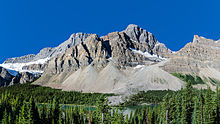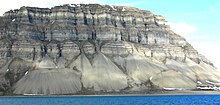Talus (geology)

The talus or the talus ( lat. Talus "ankle"; plural Tali ), also called scree , talus , rare Schuttfuß , crash dump , debris ramp or designated similarly, is a fan-shaped body of debris at the bottom of steep slopes , rock towers or rock walls . The debris is deposited mainly through landslides and similar predominantly gravitational mass movements . If, on the other hand, the rubble is transported and deposited by a river, it is referred to as an alluvial fan . The slope of a debris cone results from the rock and its angle of friction . It therefore fluctuates between 26 and 42 degrees .
The biogenic break from dead reef formers (e.g. corals ) at the foot of a reef is also known as the talus. The area covered with reef debris is called the talus zone . Although there the deposition takes place under water, it also preferably takes place gravitationally.
Origin and structure of the talus
In the geosciences, rubble is a loose sediment of mostly unsorted, angular fragments that are larger than two millimeters and therefore belong to the psephites . The material comes from weathering and erosion or denudation on steep slopes or free rock walls, which fell freely down the rocks through rockfalls or rockfalls or other geological mass movements . It is therefore a form of transport driven by gravity .
Over time, the rock debris forms a steadily growing body of debris at the foot of the slope or the rock face. The largest grain fraction ( blocks ) allows the smaller angle of curvature of their surface to float on smaller grain sizes when they fall, which is why they are transported further and are usually in the more distant area of the debris fan. A debris body that mainly consists of block debris is called a block heap . In narrow valleys and in Karen the debris from the surrounding walls mix.
A spring covered by rubble at the foot of a rock face, the water of which only emerges at the edge of the talus, is called a rubble spring .
Educational conditions

As a result of these processes, tali are found more frequently in high mountains than in low mountain ranges , since mechanical weathering processes such as frost splitting are of greater importance due to the extreme climatic conditions. Rubble fans of large mountain formations can reach enormous areas and thicknesses. In addition to the climatic conditions, the material properties of the rock are also important for the formation of the Tali. They are particularly pronounced in those mountains that consist of brittle and thus sharp-edged breaking rock, i.e. they form rubble stones .
The geometry of the debris
The way in which the rubble is conveyed determines the geometry of the rubble body. Scale promotion and linear power supply via a Traufkante leave debris piles are formed, the formation of debris bowl occurs in linear production in rockfall gutters and selective feeding in their mouths.
The shape of the talus also depends on the slope of the heaps. This is determined by the angle of friction or angle of repose of the debris. It is a measure of how steep a rubbish dump can become without slipping; a large angle of friction enables the formation of a steep slope of rubble. The angle of friction depends on the shape and size of the fragments: Round, smooth shapes reduce the angle of friction, sharp-edged, rough ones increase it. In the case of small grain sizes , strong wetting leads to a reduction in the cohesion of the material and thus a reduced angle of friction.
The volume of debris near the wall base is usually overestimated. The lower area of a rock face is protected from atmospheric weather influences by the fall debris and therefore weathers more slowly. Over time, a rock core develops in front of the wall foot, on which the upper parts of the fall debris sit.
The further development
Since the talus covers the lower part of the mountain slope , the dump slope , it is protected from further weathering and erosion. This has a significant impact on the further development of the slope: the top of the slope is eroded more quickly than the dump slope and therefore retreats ever further. As a consequence, the relief of the slope flattens out increasingly.
With the onset of weathering, the initial phase of soil formation begins , and a still raw soil, a rubble soil or syrosem , is created. If the conditions are suitable, it can later be colonized by debris vegetation made up of pioneer plants, which contribute to the consolidation of the talus with their roots.
Before that, however, the phase of internal differentiation begins: depending on the average size of the debris components, praise of different grain sizes and different mobility are formed on the surface . Under the highly mobile loose debris layer , the thickness of which depends on the average grain size, fine material created or washed away by weathering accumulates and serves as the starting material for the onset of soil formation.
In Loben with highly mobile surface rubble, pioneer vegetation accumulating due to frequent movements of material naturally occurs only slowly. The age of its surface is therefore not necessarily inferred from the growth of a debris body.
literature
- Dietmar MS Lorek: Wall and ridge development since the late glacial: a contribution to the history of the landscape in Graubünden , dissertation University of Frankfurt am Main, 2004
Web links
- Image: Structure of a reef body with talus zone (English) ( Memento from November 4, 2004 in the Internet Archive )
